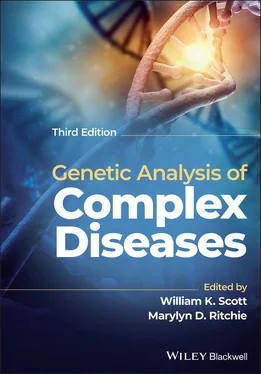Genetic Analysis of Complex Disease
Здесь есть возможность читать онлайн «Genetic Analysis of Complex Disease» — ознакомительный отрывок электронной книги совершенно бесплатно, а после прочтения отрывка купить полную версию. В некоторых случаях можно слушать аудио, скачать через торрент в формате fb2 и присутствует краткое содержание. Жанр: unrecognised, на английском языке. Описание произведения, (предисловие) а так же отзывы посетителей доступны на портале библиотеки ЛибКат.
- Название:Genetic Analysis of Complex Disease
- Автор:
- Жанр:
- Год:неизвестен
- ISBN:нет данных
- Рейтинг книги:4 / 5. Голосов: 1
-
Избранное:Добавить в избранное
- Отзывы:
-
Ваша оценка:
- 80
- 1
- 2
- 3
- 4
- 5
Genetic Analysis of Complex Disease: краткое содержание, описание и аннотация
Предлагаем к чтению аннотацию, описание, краткое содержание или предисловие (зависит от того, что написал сам автор книги «Genetic Analysis of Complex Disease»). Если вы не нашли необходимую информацию о книге — напишите в комментариях, мы постараемся отыскать её.
An up-to-date and complete treatment of the strategies, designs and analysis methods for studying complex genetic disease in human beings Genetic Analysis of Complex Diseases
Genetic Analysis of Complex Diseases
Genetic Analysis of Complex Diseases
Genetic Analysis of Complex Disease — читать онлайн ознакомительный отрывок
Ниже представлен текст книги, разбитый по страницам. Система сохранения места последней прочитанной страницы, позволяет с удобством читать онлайн бесплатно книгу «Genetic Analysis of Complex Disease», без необходимости каждый раз заново искать на чём Вы остановились. Поставьте закладку, и сможете в любой момент перейти на страницу, на которой закончили чтение.
Интервал:
Закладка:

Figure 3.3 Correlation of age of onset among siblings affected with Alzheimer disease.
Twin and Adoption Studies
Twin and adoption studies can be quite useful as they provide an opportunity to tease apart the role of genetics and a common familial environment. The most difficult aspect of these types of studies is obtaining reasonable sample sizes. This is especially true in the United States where twin, adoption, and disease registries are less common than in European countries.
The premise of twin studies is the comparison of the disease concordance in monozygotic (MZ) with dizygotic (DZ) twins. Since MZ twins share 100% of their genetic make‐up and DZ twins share on average 50% of their genetic make‐up, a greater disease concordance in MZ compared with DZ twins is consistent with the involvement of genetics. An advantage of this approach is that it controls for a common familial environment, but this is generally only applicable for exposures during childhood. It may not entirely control for prenatal exposures because the twins, especially DZ, may not have shared placentas, chorions, and amniotic sacs. However, the intrauterine and extrauterine environments are generally more similar for DZ twins than siblings. It is even less likely that adult exposures are similar among the twins, especially if they reside in different geographic locations. Other possible confounding variables controlled for in the twin study approach include age and sex (provided same‐sex DZ twins are utilized). However, keep in mind that for a condition with variable age of onset, it may be necessary to follow the twins for several years in order to conclusively determine that a set of twins is concordant or discordant for the condition. But most importantly, prior to beginning any twin study, one must determine the zygosity of the twins, as misclassification can have a devastating effect on the outcome of the analysis (Ellsworth et al. 1999). Often families will know the zygosity of the twins, but it is prudent to determine this experimentally via genotyping.
Table 3.2below shows examples of concordance rates that might be observed under various disease etiologies. In practice, the results will not be easily interpreted for complex disorders, much like the results obtained in the last row of this table. In general, however, if the frequency in concordance is greater in MZ compared with DZ twins, it is accepted as evidence for at least a minor role of genetics in the disease etiology.
Adoption studies can also be used to examine the evidence for genetic versus common familial environmental factors. In this approach, cases are ascertained and then the frequency of the condition in the biological parents is compared with the frequency of the condition in the adoptive parents. As shown below in Table 3.3, a higher disease frequency in biological parents argues for the presence of genetic factors, while a higher disease frequency in the adoptive parents argues for the presence of a common familial environmental factor. A variation on adoption studies is the adoptive‐twin approach where twins who have been reared apart are examined to determine if genetics (high concordance rate) or environment (low concordance rate) plays a role in the disease etiology.
Table 3.2 The association between disease concordance rates in twins and disease etiology.
| Frequency of disease concordance in twins | ||
|---|---|---|
| MZ (%) | DZ (%) | Possible etiology |
| 85 | 85 | Common familial environment |
| 100 | 25 | Mendelian recessive genetic factor |
| 100 | 50 | Mendelian dominant genetic factor |
| 63 | 17 | Genetic and environmental factors? |
Table 3.3 Adoptive studies and disease etiology.
| Frequency of disease in parents | ||
|---|---|---|
| Biological (%) | Adoptive (%) | Possible etiology |
| 85 | 4 | Genetic factors |
| 4 | 85 | Common familial environment |
While adoption studies are simple in theory, in reality, they are quite difficult to carry out. Achieving the necessary sample size can be challenging because of the need to identify the biological parents. Moreover, children are often placed in demographic environments similar to that of the biological parents, making it difficult to ensure that one can distinguish between genetics and environment. However, when these issues can be overcome, this approach can provide critical information regarding the etiology of complex traits. For example, this approach has been used to demonstrate that familial aggregation of multiple sclerosis is due to genetics and not a shared environment (Ebers et al. 1995), and to differentiate the role of genes and environment on various psychological measures (Bouchard, Jr. et al. 1990).
Recurrence Risk in Relatives of Affected Individuals
A trio of seminal manuscripts in complex genetic analysis, published by Neil Risch (1990a, b, c), evaluated methods for linkage analysis and determining the mode of inheritance of disease loci using affected relative pairs. The basis for these analyses is familial recurrence risk ratios ( λ R):
(3.3) 
A greater risk for disease in the relatives (of type R) of an affected individual compared with the risk in the general population is consistent with the involvement of genetics in the disease etiology. Because λ Ris a ratio, usually any value over 1.0 is considered to provide evidence for the involvement of a familial component/genetics in a condition. It is generally accepted that the larger the recurrence risk ratio, the stronger the role of genetics in the disease etiology. But this does not always hold true. Notice that the denominator in Equation (3.3)is the risk of the condition in the general population. Thus, for some common diseases, λ Ris not large but that is due to the high frequency of the condition in the general population, not due to the lack of the involvement of genetics. For example, λ sibling= 4 – 5 for Alzheimer disease (Roses et al. 1995) compared with λ sibling= 100 for autism spectrum disorder (Bolton et al. 1994; Bailey et al. 1995). In both of these complex disorders, genetics plays a significant role, but the frequency of Alzheimer disease in the general population is much higher than that of autism spectrum disorder, which contributes to the difference in the λ siblingvalues. Recurrence risk ratios are also population‐specific as the disease risk in the general population may vary by ethnicity or geographic location. Keep in mind that a high λ Rcould result from a common familial environment rather than genetics.
Risch (1990a) also demonstrated that the drop‐off in recurrence risk by degree of familial relation is related to the mode of inheritance. For a single‐gene model, λ R–1 is expected to decrease by a factor of 2 with each decreasing degree of relation. For a multiplicative model, λ R–1 will drop off more quickly with each degree of relation. Thus, by comparing the λ Rfor various types of relatives, one can determine if the disorder is consistent with a particular inheritance pattern. Brown et al. (2000) found that the recurrence risks for ankylosing spondylitis were 8.2% for first‐degree relatives, 1.0% for second‐degree relatives, and 0.7% for third‐degree relatives. Because this drop‐off rate is more rapid than a factor of 2, a single‐gene model for genetic susceptibility to ankylosing spondylitis is not likely. Using the information on recurrence risks, the authors determined that the most likely mode of inheritance for ankylosing spondylitis was an oligogenic model with a multiplicative interaction between the loci.
Читать дальшеИнтервал:
Закладка:
Похожие книги на «Genetic Analysis of Complex Disease»
Представляем Вашему вниманию похожие книги на «Genetic Analysis of Complex Disease» списком для выбора. Мы отобрали схожую по названию и смыслу литературу в надежде предоставить читателям больше вариантов отыскать новые, интересные, ещё непрочитанные произведения.
Обсуждение, отзывы о книге «Genetic Analysis of Complex Disease» и просто собственные мнения читателей. Оставьте ваши комментарии, напишите, что Вы думаете о произведении, его смысле или главных героях. Укажите что конкретно понравилось, а что нет, и почему Вы так считаете.











